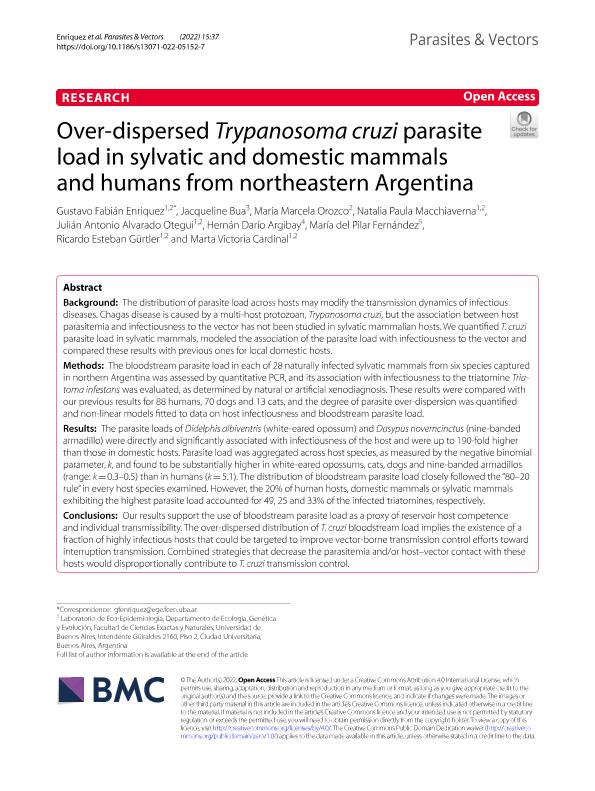Artículo
Over-dispersed Trypanosoma cruzi parasite load in sylvatic and domestic mammals and humans from northeastern Argentina
Enriquez, Gustavo Fabián ; Bua, Jacqueline Elena
; Bua, Jacqueline Elena ; Orozco, Maria Marcela
; Orozco, Maria Marcela ; Macchiaverna, Natalia Paula
; Macchiaverna, Natalia Paula ; Alvarado Otegui, Julián Antonio
; Alvarado Otegui, Julián Antonio ; Argibay, Hernán Darío
; Argibay, Hernán Darío ; Fernandez, Maria del Pilar
; Fernandez, Maria del Pilar ; Gurtler, Ricardo Esteban
; Gurtler, Ricardo Esteban ; Cardinal, Marta Victoria
; Cardinal, Marta Victoria
 ; Bua, Jacqueline Elena
; Bua, Jacqueline Elena ; Orozco, Maria Marcela
; Orozco, Maria Marcela ; Macchiaverna, Natalia Paula
; Macchiaverna, Natalia Paula ; Alvarado Otegui, Julián Antonio
; Alvarado Otegui, Julián Antonio ; Argibay, Hernán Darío
; Argibay, Hernán Darío ; Fernandez, Maria del Pilar
; Fernandez, Maria del Pilar ; Gurtler, Ricardo Esteban
; Gurtler, Ricardo Esteban ; Cardinal, Marta Victoria
; Cardinal, Marta Victoria
Fecha de publicación:
12/2022
Editorial:
BioMed Central
Revista:
Parasites and Vectors
ISSN:
1756-3305
Idioma:
Inglés
Tipo de recurso:
Artículo publicado
Clasificación temática:
Resumen
Background: The distribution of parasite load across hosts may modify the transmission dynamics of infectious diseases. Chagas disease is caused by a multi-host protozoan, Trypanosoma cruzi, but the association between host parasitemia and infectiousness to the vector has not been studied in sylvatic mammalian hosts. We quantified T. cruzi parasite load in sylvatic mammals, modeled the association of the parasite load with infectiousness to the vector and compared these results with previous ones for local domestic hosts. Methods: The bloodstream parasite load in each of 28 naturally infected sylvatic mammals from six species captured in northern Argentina was assessed by quantitative PCR, and its association with infectiousness to the triatomine Triatoma infestans was evaluated, as determined by natural or artificial xenodiagnosis. These results were compared with our previous results for 88 humans, 70 dogs and 13 cats, and the degree of parasite over-dispersion was quantified and non-linear models fitted to data on host infectiousness and bloodstream parasite load. Results: The parasite loads of Didelphis albiventris (white-eared opossum) and Dasypus novemcinctus (nine-banded armadillo) were directly and significantly associated with infectiousness of the host and were up to 190-fold higher than those in domestic hosts. Parasite load was aggregated across host species, as measured by the negative binomial parameter, k, and found to be substantially higher in white-eared opossums, cats, dogs and nine-banded armadillos (range: k = 0.3–0.5) than in humans (k = 5.1). The distribution of bloodstream parasite load closely followed the “80–20 rule” in every host species examined. However, the 20% of human hosts, domestic mammals or sylvatic mammals exhibiting the highest parasite load accounted for 49, 25 and 33% of the infected triatomines, respectively. Conclusions: Our results support the use of bloodstream parasite load as a proxy of reservoir host competence and individual transmissibility. The over-dispersed distribution of T. cruzi bloodstream load implies the existence of a fraction of highly infectious hosts that could be targeted to improve vector-borne transmission control efforts toward interruption transmission. Combined strategies that decrease the parasitemia and/or host–vector contact with these hosts would disproportionally contribute to T. cruzi transmission control.
Archivos asociados
Licencia
Identificadores
Colecciones
Articulos(IEGEBA)
Articulos de INSTITUTO DE ECOLOGIA, GENETICA Y EVOLUCION DE BS. AS
Articulos de INSTITUTO DE ECOLOGIA, GENETICA Y EVOLUCION DE BS. AS
Articulos(SEDE CENTRAL)
Articulos de SEDE CENTRAL
Articulos de SEDE CENTRAL
Citación
Enriquez, Gustavo Fabián; Bua, Jacqueline Elena; Orozco, Maria Marcela; Macchiaverna, Natalia Paula; Alvarado Otegui, Julián Antonio; et al.; Over-dispersed Trypanosoma cruzi parasite load in sylvatic and domestic mammals and humans from northeastern Argentina; BioMed Central; Parasites and Vectors; 15; 1; 12-2022; 1-14
Compartir
Altmétricas



